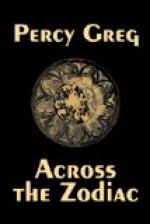In this balloon journey I had a specially advantageous opportunity of observing the two moons—velnaa, as they are called. Cavelna, or Caulna, the nearer, in diameter about 8’ or a little more than one-fourth that of our Moon, is a tolerably brilliant object, about 5000 miles from the surface. Moving, like all planets and satellites, from west to east, it completes its stellar revolution and its phases in less than seven and a half hours; the contrary revolution of the skies prolongs its circuit around the planet to a period of ten hours. Zeelna (Zevelna) returns to the same celestial meridian in thirty hours; but as in this time the starry vault has completed about a rotation and a quarter in the opposite direction, it takes nearly five days to reappear on the same horizon. It is about 3’ in diameter, and about 12,000 miles from the surface. The result of the combined motions is that the two moons, to the eye, seem to move in opposite directions. When we rose above the mists, Caulna was visible as a very fine crescent in the west; Zeelna was rising in the east, and almost full; but hardly a more brilliant object than Venus when seen to most advantage from Earth. Both moved so rapidly among the stars that their celestial change of place was apparent from minute to minute. But, as regarded our own position, the appearance was as opposite as their direction. Zeelna, traversing in twelve hours only one-fifth of the visible hemisphere, while crossing in the same time 144 deg. on the zodiac—twelve degrees per hour, or our Moon’s diameter in two minutes and a half—was left behind by the stars; and fixing what I may call the ocular attention on her, she seemed to stand still while they slowly passed her; thus making their revolution perceptible to sense as it never is on Earth, for lack of a similar standard. Caulna, rising in the west and moving eastwards, crossed the visible sky in five hours, and passed through the stars at the rate of 48 deg. per hour, so that she seemed to sail past them like a golden cloudlet or celestial vessel driven by a slow wind. It happened this night that she passed over the star Fomalhaut—an occultation which I watched with great interest through an excellent field-glass, but which lasted only for about half a minute. About an hour before midnight the two moons passed each other in the Eastern sky; both gibbous at the moment, like our Moon in her last quarter. The difference in size and motion was then most striking; Caulna seeming to rush past her companion, and the latter looking like a stationary star in the slowly moving sky.




